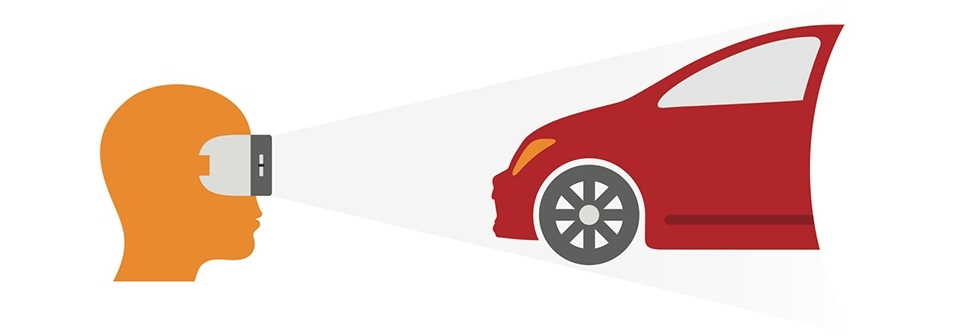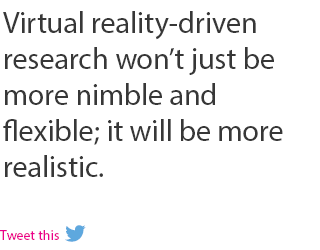Virtual reality is the next big thing in digital, with virtual environments spreading beyond the gaming and entertainment worlds and hitting the mainstream in the form of Oculus Rift, HTC Vive and Sony Playstation VR. These products have consumers and the mainstream media excited.  But consumer’s excitement around virtual reality is nothing compared to its potential impact on auto research. Virtual Reality (VR) isn’t just a means of testing products cheaply or more efficiently; it’s an opportunity to wholly reinvent the role of research within the auto industry.
But consumer’s excitement around virtual reality is nothing compared to its potential impact on auto research. Virtual Reality (VR) isn’t just a means of testing products cheaply or more efficiently; it’s an opportunity to wholly reinvent the role of research within the auto industry.
Richer and faster insights
We can start by broadening the scope and definition of auto research. Now that we can simulate realistic virtual reality environments through a headset anywhere and anytime, we can move beyond the idea of centralised car clinics. We can conduct research into new vehicle concepts far earlier in the process, before a physical prototype has even been produced, and we can do so across a far more representative sample of consumers, locations and markets. As augmented reality technology (the super-imposing of different scenarios on the physical world) catches up with its virtual reality cousin, motor shows could become an ideal environment for gathering insights, where we can gauge consumer reactions to different colours and trim options by changing what people see at the touch of a button.
Virtual reality-driven research won’t just be more nimble and flexible. It will also be, ironically enough, more realistic (even without sitting in a vehicle and experiencing it through touch and smell). Within a few years if not months, we will be able to immerse consumers in evocative recreations of showrooms where they can walk amongst competing vehicles (the specs, look and feel of which have been captured virtually, stored and downloaded), and explore new prototypes on their own terms. Rather than following an artificially structured questionnaire, we can introduce questions and prompt responses at the most relevant moments as they look around the vehicle. And we can introduce new, observational elements to new car research by capturing precisely how participants’ attention moves from one feature to another. After all, every movement of their head and eyes takes place within a digitised and data-capturing environment.
Making it real
What will it take to make this virtually enabled, better reality an operational reality? The short answer is: the right partnerships. Developing new technologies involves considerable costs – and a certain amount of trial and error. Partnering with the right experts can give our use of virtual and augmented reality a clearer and more purposeful direction – and it can make its possibilities available to auto manufacturers sooner. Yet tapping the potential of new realities will also involve its own research. As we rewrite the scope and structure of new vehicle testing we need to understand how the new metrics that we are developing relate to the old: Are they strictly comparable? How should they be weighted and modelled? As with any advance in research technology, understanding the significance of what we are seeing will be crucial.
Finally,  exploring the possibilities of virtual and augmented reality will drive closer collaboration between researchers and manufacturers themselves. The deeper our understanding of business issues, the more applications we can find where new reality technologies can help address them. It will start with product development, but it won’t necessarily end there. Once virtual and augmented reality are operationalised within research, could they not be operationalised within the showroom as well? Could the augmented reality that has the potential to guide buyers through different trim options as they look at a real car also guide drivers by superimposing navigation or traffic information on Google Glass-style displays? Helping auto customers to explore the world in new ways has many potential applications. We must be bold in making use of them.
exploring the possibilities of virtual and augmented reality will drive closer collaboration between researchers and manufacturers themselves. The deeper our understanding of business issues, the more applications we can find where new reality technologies can help address them. It will start with product development, but it won’t necessarily end there. Once virtual and augmented reality are operationalised within research, could they not be operationalised within the showroom as well? Could the augmented reality that has the potential to guide buyers through different trim options as they look at a real car also guide drivers by superimposing navigation or traffic information on Google Glass-style displays? Helping auto customers to explore the world in new ways has many potential applications. We must be bold in making use of them.










